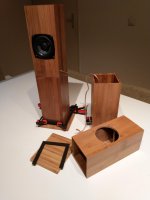Purchased 2 of these drivers with the intention to build a set of small ML-TL's. Before the actually build I want to do some simulations to get an idea of what can be achieved. Tried to measure the FS of these and think I measured 107 Hz. Put to one of the drivers about 10 hours of music and measured again: 103 Hz. Way higher compared to the specs: 82 Hz.
I measured using Limp (Arta), the headphone output and a 50 ohm resistor.
As I can't be accused of much experience, thought some on this forum could say something sensible on this phenomenon
Appreciate any feedback.
-Rolf
I measured using Limp (Arta), the headphone output and a 50 ohm resistor.
As I can't be accused of much experience, thought some on this forum could say something sensible on this phenomenon
Appreciate any feedback.
-Rolf
Loosening the suspension should lower Fs somewhat. But welcome to the world of
a/ Production tolerances, and
b/ Variations in data produced by different test hardware and methodologies.
This is not a reflection on any person, hardware or drive unit. For example, I'm currently having a merry time trying to reconcile data taken by the now unfortunately obsolescent LMS, with data of the same drivers taken using a current version of Clio. Suffice it to say, if I had uttered over the blower some of the language I have been using, the CPS would do me for an obscene 'phone call.
a/ Production tolerances, and
b/ Variations in data produced by different test hardware and methodologies.
This is not a reflection on any person, hardware or drive unit. For example, I'm currently having a merry time trying to reconcile data taken by the now unfortunately obsolescent LMS, with data of the same drivers taken using a current version of Clio. Suffice it to say, if I had uttered over the blower some of the language I have been using, the CPS would do me for an obscene 'phone call.
Didn't play very loud as without enclosure it sounds a bit too harsh. Will give that definitely a try now.
Tnx Chris
No problem. Feel free to turn the bass up to get the cones moving without the mid/high range getting too loud.
Chris
@Scottmoose
value much your feedback as I am a newbie as I have some technical background and understand your remarks on tolerantes and measure methods.
I should have mentioned before but I did similar measurements on 2 other small drivers, just out of the box:
PS95-8 fs specs 120Hz, measured 120 Hz (same brand)
TG9FD-10-04 fs specs 113Hz, measured 134 Hz
That's why I was puzzled on the 25%> Fs off specs of the PC83-4's
value much your feedback as I am a newbie as I have some technical background and understand your remarks on tolerantes and measure methods.
I should have mentioned before but I did similar measurements on 2 other small drivers, just out of the box:
PS95-8 fs specs 120Hz, measured 120 Hz (same brand)
TG9FD-10-04 fs specs 113Hz, measured 134 Hz
That's why I was puzzled on the 25%> Fs off specs of the PC83-4's
[Potentially] different factories or lines, different part tolerances, different batches, different driver types all play a role. There is never a fixed set of conditions that applies across the industry, because there are no obligatory standards; you'll find it varies even within brands (with a handful of exceptions). It's a fairly large deviation on Fs, where things are often tighter, but I've seen equal or greater. Depending on the spider design you might see that drop by about 10% as the official measurements state modest mechanical damping at resonance; I'd be surprised if it dropped significantly more than that though.
- Status
- This old topic is closed. If you want to reopen this topic, contact a moderator using the "Report Post" button.
- Home
- Loudspeakers
- Full Range
- Newbie question on DA PC83-4
